 |
[IP
Telephony Cookbook] /
Setting up Value-added
Services
Setting
up Value -added Services |-
6
This
chapter introduces the
concept of added-value services
and their implementation in
IP
Telephony
products.Value-added services are
services that integrate VoIP
with other protocols
and
services.
Seamless integration with Web,
E-mail and potential other
Internet services
provides
convenience
which, is a key feature of
Internet telephony.
|-
6.1
Web integration of H.323
services
A
natural extension to any
Internet service nowadays is
its integration with the
Web.
Unfortunately,
H.323 is more difficult to integrate
with Web interfaces than
SIP, due to the
complexity
of the protocol and its
roots in the telecom world.Web
applications that would
be
much
needed in the area are
the following:
-
Presence:
Web-based
applications that allow a
group of users to indicate their
availability for
accepting
calls and to check
availability of others. Analogous to
the classic ICQ-type
application,
H.323
presence applications could stir-up significantly
more users if they were
widely available;
-
Click-to-dial:
Web-based
applications that allow
users the ease to click in
order to make a call
to
a target endpoint, service set up or
user. Obviously, H.323 endpoint
applications are
harder
to
set up than e.g., MP3
client-applications that download media
streams, and this has a
limiting
effect
on their use. Achieving the
ease of use of a click-to-dial interface
would have a dramatic
effect
on the deployment of
H.323;
-
IPPBX
management: Web-based
applications that allow
administrators of an IP-based
PBX
system
to monitor and control calls
being made.The simplicity of
use of such Web
interfaces
would
allow the equivalent of a
switchboard operator to:
transfer calls, initiate
multi-party calls,
answer
calls on busy, and terminate
calls.
The
applications above are mostly found in
commercially-available integrated
solutions and they
employ
proprietary methods that are extremely
difficult to integrate with
custom-made Web
interfaces.
If you are interested in
setting up your own Web-based
application and integrate
it
with
your H.323 services, you
must find the means of
connecting it to the gatekeeper
you have
deployed.The
methods are many and
vary from gatekeeper to
gatekeeper, depending on
the
available
APIs and supported
interfaces.
In
this section, we will simply
list some of the options
available for interfacing with
common
gatekeepers.
For more information please
refer to Appendix B.
|-
6.1.1
RADIUS-based methods
If
you are simply interested in
making a presence application, then
any gatekeeper with
RADIUS
support
can be interfaced with, through
proper RADIUS server set-up.
For example, the
P.173
[IP
Telephony Cookbook] /
Setting up Value-added
Services
FreeRADIUS
server can be configured to
execute an external script each
time an authentication
is
made.This method can be used to
keep a list of currently registered
endpoints on the
gatekeeper
and make it available over
the Web as a primitive means
of advertising availability. A
slightly
better method would be to configure
FreeRADIUS with MySQL
back-end and maintain
a
database table with currently
registered endpoints, by updating
the table for each
RADIUS
event
(authentication and
accounting).
|-
6.1.2.
SNMP-based methods
An
alternative to the above method is to
use SNMP to interface with
your gatekeeper, assuming
it
has SNMP support.The Cisco MCM has SNMP
support but with limited
functionality, while
the
RADVISION ECS supports the
H.341 standard for SNMP
access.You can explore
the
options
available to an external application, interfacing
with SNMP by carefully
studying the
supported
MIBs for your
gatekeeper.
|-
6.1.3
Cisco MCM GK API
The
Cisco MCM Gatekeeper actually implements
a very flexible API for
receiving events that
the
administrator
is interested in processing.The external
application can choose to further
process
the
event, or just log it for
informational purposes.The API
interface to the MCM is
proprietary
and
based on the GKTMP ad-hoc
protocol for informing the external
application of RRQ,
URQ,
ARQ,
LRQ,
DRQ,
BRQ
and
related (confirm/reject) events.The
API allows the
external
application
to issue respective confirm
and reject (xCF,xRJ)
commands for specific
events, based
on
external application logic. Cisco
provides a library in C and
template code for an
external
application,
but it is not fully working
code and requires
significant resources to be applied
before
a
demo application can be
built. Also commercial solutions from
Cisco partners exist which
are
based
on this same API (see GK
API Guide Version
4.2).
|-
6.1.4
GNU GK Status Interface
The
GNU Gatekeeper provides a very
useful command-line interface
for monitoring and
control
of
gatekeeper operations. It is called
the `Status Interface' and
allows telnet connections
from
remote
administrative nodes to connect
and monitor RCF/RJ,
UCF/RJ,
ACF/RJ,
LCF/RJ,
DCF/RJ,
BCF/RJ
events
with detailed
information.
Additionally,
it allows monitoring of call
detail records (CDR) for
accounting applications
and
RouteRequest
messages
for interfacing with the
`Virtual Queues' feature, proprietary to
the
GNU
Gatekeeper.The fact that
many different nodes can
connect at the same time
over this
administrative
interface and process different
events of the gatekeeper,
allows for a distributed
and
flexible
implementation of monitoring services.
Indeed, a number of tools have
been developed
that
build on this interface and
provide interesting
functionality:
-
OpenH323
Gatekeeper Java GUI: this
interface allows the
monitoring of registrations
and
calls
on the gatekeeper and
provides endpoint information as well.
Source code is available
to
modify
for added functionality, if
needed;
P.174
[IP
Telephony Cookbook] /
Setting up Value-added
Services
-
Sample
ACD application: this
interface allows the
definition and management of
groups of
endpoints
(agents) who will handle a
large volume of calls for a
single alias.The ACD
will
check
which of the agents is qualified
and available (not in another
call and not logged
off from
ACD
work) and informs the
gatekeeper which agent will
receive the call. If no
agent is
available,
the ACD will tell
the gatekeeper to reject the
call. All call routing
logic is kept out of
the
gatekeeper to ensure stable
operation, while routing
logic can be changed
frequently;
-
PHP
GNUgk Status Monitor - v0.4:
this application allows
monitoring of registered
endpoints
and calls in progress through a
PHP Web interface. Call
disconnection is possible
and
further
functionality is being developed.
Source code is
available.
|-
6.2
Web integration of SIP
services
This
chapter provides an overview of
some added-value services implemented
using a Web
interface.
Serweb, the Web interface
for the SIP Express
Router described in Chapter 4,
will be
used
as an example implementation of Web-based
added-value services for
SIP
Integration
of SIP services with Web
interface is the most common
scenario. A Web interface
is
often
used for the provisioning of
SIP products and for
the implementation of advanced
services.
Web
browsers are available in
the vast majority of existing
operating systems.
|-
6.2.1
Click-to-dial
Click-to-dial
is a method of establishing a call
between participants using a
Web interface. It
greatly
simplifies dialling, in that calling
parties do not have to dial
lengthy addresses and
they
keep
their phonebooks separately
from SIP phones. In its
simplest form, a user has a
Webpage
where
he can enter the SIP
addresses of two users, and
the SIP user agents of
those two users
get
connected.We
will focus on REFER-based
click-to-dial.
A
REFER-based
click-to-dial scenario is based on
the paradigm of intelligent
end-devices and
dumb
network. One of the involved
SIP user agents is asked to
connect to the other and
report to
the
server when it is
done.
The
drawback of this approach is
that one of the involved SIP
user agents must support
the
REFER
SIP
method which has been standardised
recently (see RFC3515).The big
advantage
that
balances the previous
drawback is that it is extremely easy to
implement REFER-
based
click-to-dial
in the server. Call-flow for
REFER-based
click-to-dial is depicted in Figure
6.1.
First,
the SIP server sends an
INVITE
to one of
the phones because phones
usually do not accept
REFER
without
prior invitation.The INVITE
contains
0.0.0.0 as the IP address in
SDP, because
there
is no remote phone (the
message is sent by user
agent within the SIP
server which does
not
deal
with media).
After
that, the server sends a
REFER
method
which will ask the
phone to send INVITE
somewhere
else.The URI of the called
party is passed to the phone
in a Refer-To
header
field of
the
REFER
method.
P.175

[IP
Telephony Cookbook] /
Setting up Value-added
Services
The
phone sends a NOTIFY
method
back to the server once
the connection is established.
The
click-to-dial feature allows
the creation of many
advanced features, like phone-book,
in
which
you can click on an entry
and your phone and phone of
the person represented by
the
entry
are connected.You can
implement a list of missed call in
exactly the same way and
clicking
on
an entry in the list will connect your
phone with that person.
There are many others
possible
scenarios.
SIP
Server
UA1
UA2
INVITE
200
OK
ACK
REFER
Refer-To:
UA2
202
Accepted
INVITE
200
OK
ACK
NOTIFY
200
OK
Figure
6.1 REFER-based
click-to-dial
|-
6.2.2
Presence
It
is also possible to display
the presence of SIP users in
a Webpage (for example, in a
phone-
book).
Displaying the on-line status of
subscribers allows calling parties to
determine availability
and
willingness to have a conversation conveniently.The
status may be shown, for
example, in the
calling
party's phonebook or on the
called party's homepage.
Linking on-line users to
click-to-
dial
applications greatly integrates
telephony with the Web
and introduces convenience to
users.
When
a SIP phone registers, the
SIP server records this
information into a database.The
Web
server
can then access the
database to see if a user is online or
offline.
Go
to iptel.org,
create a new account, and
insert some entries into
your phone-book to see
how
it works.
P.176
[IP
Telephony Cookbook] /
Setting up Value-added
Services
|-
6.2.3
Missed calls
`Missed
calls' is a feature that
allows a user to display the
list of call attempts that
were made during
the
period when he was not online
(registered in SIP).The list can be
presented on a Web
page.
Recording
missed calls has a lot in
common with accounting.
Servers doing accounting log
some
information
when a call is successfully
established and torn
down.When a calling party gets
a
negative
final response to his call, or
does not receive any
reply at all (timeout), then
the server
also
records this event with a
flag, indicating that it was a
missed call.This information can be
later
used
to compile the list of missed
calls.
|-
6.2.4
Serweb
Serweb
is a Web front-end for a SIP
Express Router (see Section
4.6.2 for more details).
Serweb
creates
a user interface for users
of the proxy server, where
they can manage their
account, change
their
configuration and do many advanced
things.
|-
6.2.4.1
Installation
Serweb
is a set of php scripts.To run
it, you will need
Apache Web server with
php and mysql
support.
Because a SIP Express Router
and serweb talk together
using a FIFO interface, the
SIP
Proxy
and the Web server
must be running on the same
machine.
Get
serweb from http://developer.berlios.de/projects/serweb
and
untar
the
archive.
It is recommended not to untar
it to the
document root of your Web server.
Alternatively
you
can get serweb using
CVS:
lexport
CVSROOT=:pserver:anonymous:@cvs.berlios.de:/cvsroot/serweb
cvs
login
cvs
co iptel
|-
6.2.4.2
Configuration
The
entire configuration of serweb is in config.php
file in html subdirectory.You
will need to
configure
the following:
-
Host on which MySQL server
is running:
$this->db_host="localhost";
-
Path of the user interface
on the Web server:
$this->root_path="/";
-
Root URI of the Web
server:
$this->root_uri="http://www.foobar..."
-
Path of serweb images on the
Web server: $this->img_src_path =
$this-
>root_path."iptel_img/";
-
Path of java script files of
serweb: $this->js_src_path =
$this-
>root_path."iptel_js/";
-
Path of ccs files of serweb:
$this->style_src_path = $this-
>root_path."iptel_styles/";
P.177
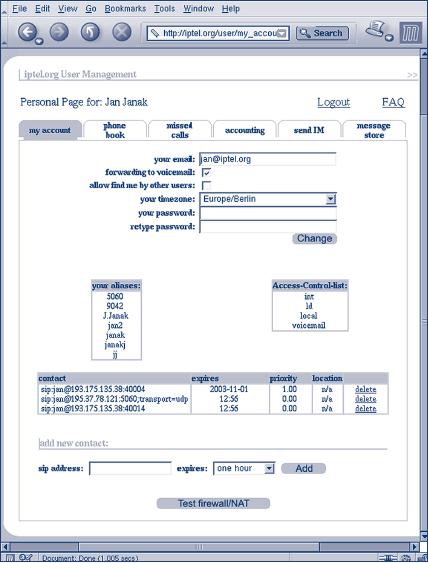
[IP
Telephony Cookbook] /
Setting up Value-added
Services
It
is necessary to create some
aliases in the configuration file of
Apache Web server:
Alias
/iptel_img
"/var/www/iptel/html/img"
Alias
/iptel_styles
"/var/www/iptel/html/styles"
Alias
/user
"/var/www/iptel/html/user_interface"
Alias
/admin
"/var/www/iptel/html/admin"
Do
not forget to update the
directory path according to your real
settings and make sure
that you
have
register_globals
and
short_open_tag
set to
On
in your
php.ini file.
|-
6.2.4.3
Operation
To
login into serweb open:
http://<your_server>/user
in
your Web browser.
You
will be prompted for username
and password.The username
and password is same as the
one
you
are using in your SIP user
agent to register at the
server.
Figure
6.2 Serweb - My
Account
P.178
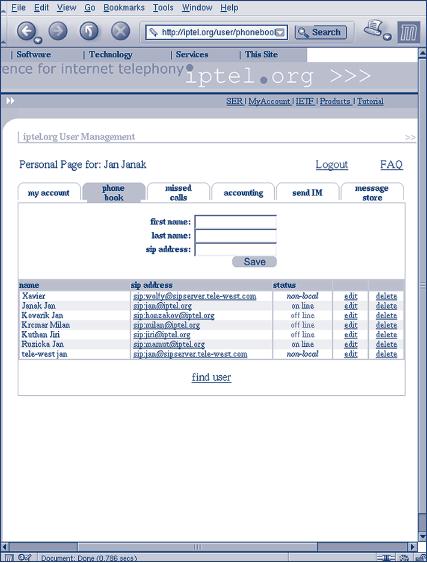
[IP
Telephony Cookbook] /
Setting up Value-added
Services
The
My
Account tab
(see Figure 6.2) allows
users to change their
preferences and
modified
registered
contacts.They can also see
aliases they created and
permissions for calling to the
PSTN.
Users
can also create their
own phone book (see
Figure 6.3). In the
phonebook, you can see
the
presence
status of each user. If the
user is currently registered, then
you will see online
in
the
status
column. If he is not registered
then you will see offline
and if
the user does not
belong to
administrative
domain of the server, then
you will see non-local.
Figure
6.3 Serweb -
Phonebook
Clicking
on the address of a user
will establish a phone call
between your and his phone,
provided
that
your phone supports REFER, as
described in Section
6.2.1.
The
missed
calls plane (see
Figure 6.4), allows users'
to see their missed calls. Again,
clicking on
an
entry will connect you with
that user
and
status
describes
presence of the user as
described in
the
previous section.
P.179
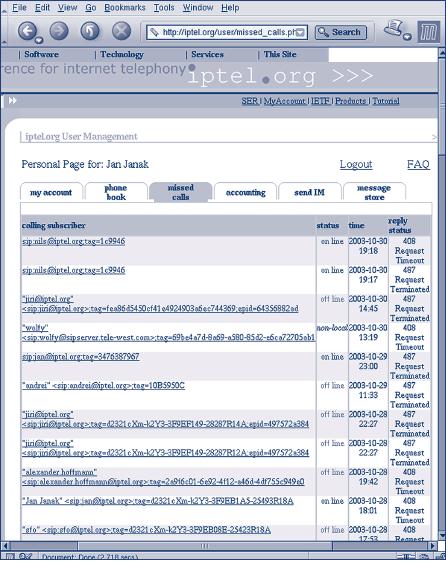
[IP
Telephony Cookbook] /
Setting up Value-added
Services
Figure
6.4 Serweb - Missed
calls
When
anyone sends a SIMPLE
message
to a user that is currently not online,
the server will
store
the
message and send it later
when the recipient comes online. In
the plane message
store (see
Figure
6.5), you can see all
messages that are stored
for you.
|-
6.2.5
SIP Express Router message store
Message
store has been implemented as a separate
module for a SIP Express
Router.To use the
module,
you will need to load
the module:
loadmodule
"/usr/local/lib/ser/modules/msilo.so"
Configure
the address of the server
(it will be used when
sending stored messages) and
the URL
of
the database:
modparam("msilo",
"registrar",
"sip:registrar@<your_domain>")
modparam("msilo",
"db_url",
"sql://ser:passwd@dbhost/ser")
P.180
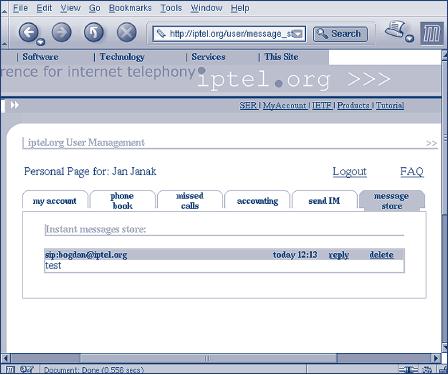
[IP
Telephony Cookbook] /
Setting up Value-added
Services
Figure
6.5 Serweb - Message
store
Then,
when the server receives a
MESSAGE
request
and it cannot deliver it
because the
recipient
is offline, it will save the
message:
if
(!lookup("location")) {
if
(method == "MESSAGE") {
if
(!t_newtran()) {
sl_reply_error();
break;
};
if
(m_store("0")) {
t_reply("202",
"Accepted for Later
Delivery");
break;
};
t_reply("503",
"Service Unavailable");
break;
};
};
When
the lookup
of
recipient's location fails (the recipient
is not registered), a new
transaction is
created
(needed for msilo
module).
Save the message using
the m_store
command,
and reply
with
202
accepted .
P.181
[IP
Telephony Cookbook] /
Setting up Value-added
Services
Each
time we call save
(location), we
have to check if the
previously available user is
registered
again
and if so, then send
the stored messages.The
following example shows how
to do that:
if
(!save("location")) {
sl_reply_error();
};
m_dump();
Command
m_dump
checks if
the registering user has any
stored messages and if so,
sends them.
|-
6.3
Voicemail
Another
Internet application which
lends itself for integration
with telephony is e-mail.
A
traditional
PSTN application, which can
be replaced with VoIP and
e-mail, is voicemail.
Traditional
PSTN voicemail systems feature
fairly inconvenient user interface
for message
retrieval:
IVR (Interactive Voice Responder). Calling
parties have to navigate through
an
automated
voice menu, listen to lengthy
announcements, type digits as prompted
and be very
patient
to achieve very simple
tasks. It is undoubtedly more convenient to
deliver recorded
messages
to the called to party by
e-mail.The called party can
then listen, store and
process the
received
messages at his convenience.The
following picture shows the
data flow in a
voicemail-
to-e-mail
scenario. An open-source
voicemail-to-e-mail application, SEMS, is
available from
iptel.org.
SEMS
stands for SIP Express
Media Server. It is an application
framework that offers easily-built
applications
dealing with media
streams.The framework itself provides
only minimal
functionality
for
accessing and manipulation of media
streams and signalling.
High-level logic is stored
in
additional
modules that can be dynamically
loaded.
Examples
of such modules are voicemail,
announcement server and ISDN
gateway.
Some
other voicemail systems exist
including OpenAM, which is
available from the
OpenH323
Website
and a voicemail system built-in
inside the VOCAL
system.
Unfortunately,
they are not easy to
set up and they are
not yet ready to be used in
a production
environment
if you need a completely integrated
product.They do not work without
bugsand
they
can easily be customised for
small environment scenarios.
P.182
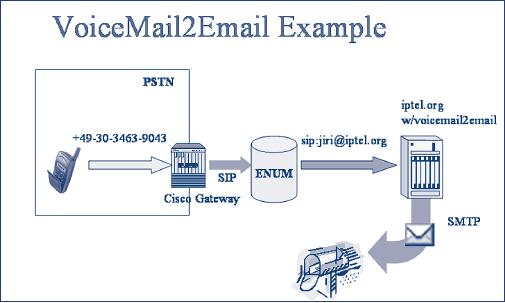
[IP
Telephony Cookbook] /
Setting up Value-added
Services
Figure
6.6 Voicemail
P.183
Table of Contents:
- INTRODUCTION:Goal, Reasons for writing this document, How to read this document
- TECHNOLOGICAL BACKGROUND:Components, Terminal, Protocols, SIP
- IP TELEPHONY SCENARIOS:Long-distance least cost routing, Integration of VoIP and videoconferencing
- SETTING UP BASIC SERVICES:General concepts, Dial plans, Authentication
- SETTING UP ADVANCED SERVICES:Gatewaying, Accounting gateways, Multipoint conferencing
- SETTING UP VALUE-ADDED SERVICE:Web integration of H.323 services, Web integration of SIP services
- INTEGRATION OF GLOBAL TELEPHONY:Technology, Call routing today,
- REGULATORY / LEGAL CONSIDERATIONS:Regulation of Voice over IP in the European Union, Numbering
- ANNEX A. European IP Telephony Projects:Evolute, SURFWorks, VC Stroom
- ANNEX B. IP Telephony Hardware/Software:Softphones, Hardphones, Gateways
- GLOSSARY:Call Processing Language, Gatekeeper, Media Gateway Control Protocol